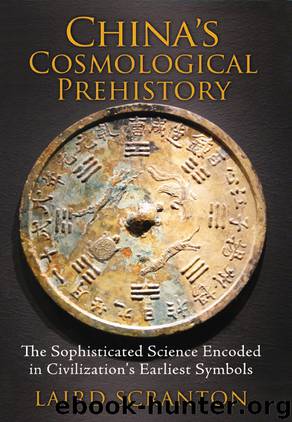China's Cosmological Prehistory by Laird Scranton

Author:Laird Scranton
Language: eng
Format: epub
Tags: Spirituality/Ancient Mysteries
Publisher: Inner Traditions / Bear & Company
Published: 2014-07-25T04:00:00+00:00
8
THE MANDALA
The mandala is widely recognized as a central symbol of Chinese cosmology, in much the same way that the figure is treated as sacred in the cosmologies of India and other parts of Asia. In The Symbolism of the Stupa, Adrian Snodgrass tells us that, although it can take many diverse forms, the mandala is basically a circle that has been inscribed inside a square, once again bringing its meaning around to the symbolic squaring of a circle. He tells us that the geometric characteristics of a mandala are effectively the same as the characteristics of the plan of a Buddhist stupa. Further affirmation for the parallels we have described in our studies between the Buddhist and Dogon ritual shrines is found in Carl Jung’s book Mandala Symbolism. Here Jung provides us with a positive link between the circular plan of the mandala and the egg-in-aball figure as it is described by the Dogon priests when he states that, in the study of alchemy, the circle of the mandala represents the synthesis of the four primordial elements.1
Snodgrass overtly tells us that, like a stupa, the mandala is laid out in accordance with ritualized principles that define the “squaring of the circle.”2 This view is again echoed by Jung, who also explicitly associates the principles of the squaring a circle with the mandala and considers this concept to be “one of the many archetypical motifs” that form the basis of human psychology and dreams.3 If we look at the mandala in terms of known Chinese symbolism of geometric shapes as discussed in previous chapters, wherein a circle is taken to represent the concept of heaven and the square to represent the concept of Earth, then the mandala can be seen as a figure that reconciles the relationship between the two concepts. To the extent that a mandala is like the plan of a stupa, we can say that its form also illustrates the fundamental principles of the ordering of space.
In keeping with these parallels between the mandala and the base plan of a stupa, it is interesting that initiates to the Tibetan Buddhist tantric tradition are routinely taught to design mandalas and are ultimately expected to be able to do so from memory. We can see from figure 8.1 that the method used to plot these figures is outwardly similar to the geometry that is used to align a Buddhist stupa. Early in their initiation process Buddhist initiates construct temporary mandalas out of colored sand, which are typically displayed on a raised terrace or platform. The central square of the mandala is measured as 8 × 8 proportional units, the same as the measure in cubits of the square roof of a Dogon granary. These are the same dimensions that also represent the traditional measurements of a Vedic altar.4
Both Jung and Snodgrass report that, in Sanskrit, the word mandala means “circle.” Snodgrass tells us that it also implies the concept of a “centered space,” a space that has been enclosed and made sacred so as to facilitate ritual acts.
Download
This site does not store any files on its server. We only index and link to content provided by other sites. Please contact the content providers to delete copyright contents if any and email us, we'll remove relevant links or contents immediately.
| Anthropology | Archaeology |
| Philosophy | Politics & Government |
| Social Sciences | Sociology |
| Women's Studies |
Cecilia; Or, Memoirs of an Heiress — Volume 1 by Fanny Burney(32396)
Cecilia; Or, Memoirs of an Heiress — Volume 3 by Fanny Burney(31779)
Cecilia; Or, Memoirs of an Heiress — Volume 2 by Fanny Burney(31751)
The Great Music City by Andrea Baker(31228)
We're Going to Need More Wine by Gabrielle Union(18927)
All the Missing Girls by Megan Miranda(15445)
Pimp by Iceberg Slim(14264)
Bombshells: Glamour Girls of a Lifetime by Sullivan Steve(13942)
Talking to Strangers by Malcolm Gladwell(13159)
Norse Mythology by Gaiman Neil(13156)
Fifty Shades Freed by E L James(13140)
For the Love of Europe by Rick Steves(12458)
Crazy Rich Asians by Kevin Kwan(9143)
Mindhunter: Inside the FBI's Elite Serial Crime Unit by John E. Douglas & Mark Olshaker(9131)
The Lost Art of Listening by Michael P. Nichols(7375)
Enlightenment Now: The Case for Reason, Science, Humanism, and Progress by Steven Pinker(7115)
The Four Agreements by Don Miguel Ruiz(6564)
Bad Blood by John Carreyrou(6509)
Weapons of Math Destruction by Cathy O'Neil(6101)
